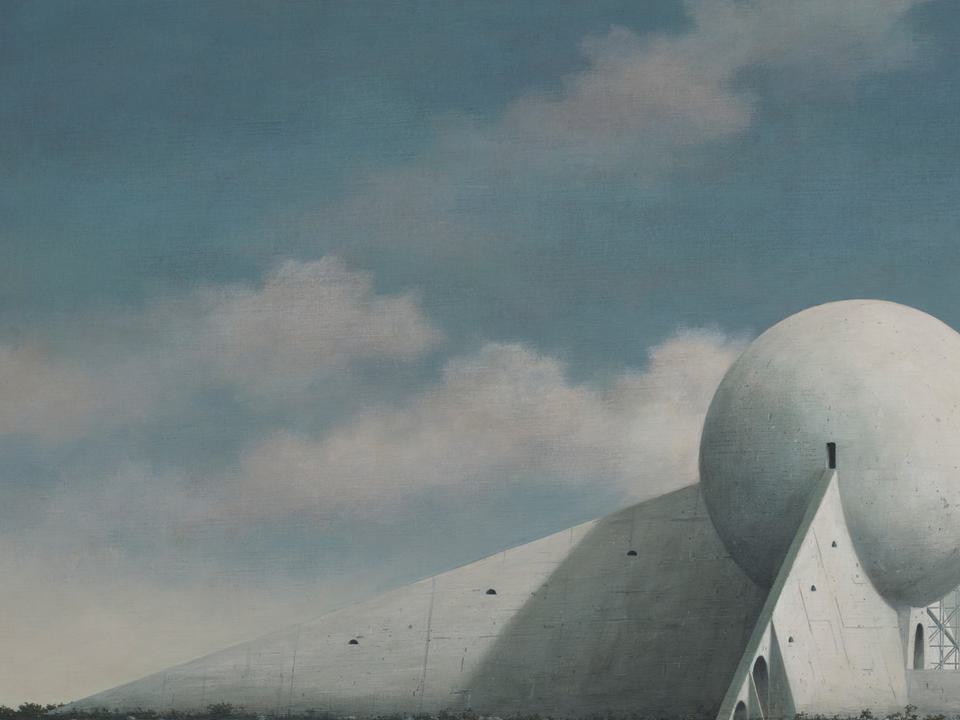
UNBUILT
Minoru Nomata
UNBUILT
8 September – 13 November 2021
Dates
8 September – 13 November 2021
White Cube is pleased to present ‘UNBUILT’, an exhibition of paintings and drawings by Japanese artist Minoru Nomata, his first in Greater China. Drawn from several series, the presentation includes works from 1987 to 2020 and highlights the artist’s continued focus on imaginary architecture and ambient landscapes devoid of human presence. The paintings feature forms and structures of indeterminate periods, which emerge from Nomata’s hybrid architectural language — a blend of the industrial, the fantastical, the archaic and the futuristic — and develop from the artist’s iterative process. Often beginning with sketches from a found image, these are then transformed over a period of months, years or even decades. Reflecting upon a condition of monoculture, technological pursuit and overarching human endeavour, Nomata conjures an oneiric world imbued with suspense and uncertainty.
The earliest work in the exhibition reflects Nomata’s interest in Classical, Renaissance and Medieval sources. Titled Decors–5 (1987), it features a bone-white conical tower with doorway and alcoves cut into its volume, on top of which sits the statue of a rider and horse marching eastwards, an abandoned civic monument that, perhaps, once heralded bright new futures. Set against a uniform, earth-tone background, a number of small columns scattered at ground level suggest that this might depict an architectural model, albeit one recording historical ruins rather than proposing tomorrow’s edifices.
In Nomata’s early works the influence of Charles Sheeler, a 20th-century American ‘precisionist’ painter who focused on machine-age aesthetics and industrial landmarks, is apparent. However, the pervading atmosphere of his paintings Nomata has stated is more broadly inspired by music, especially that of Brian Eno or Erik Satie, while the distinctive colour palette and painterly language relates to the early works of French painter Henri Rousseau. Informed in particular by Rousseau’s scenic effects, Nomata’s use of a relatively flat style and shallow depth of field results in a sense of the theatrical or artificial, as if in his paintings’ buildings are constructions on a stage-set, placed in front of a simulated backdrop of sky and cloud formations. Carrying this through to the display of his works in this exhibition, the artist here presents his paintings on wooden structures loosely based on Japanese ‘Chigaidana’ shelving. Hanging several of these paintings set within the framework of these structures and placed at different heights, the slim partitions serve to encourage the viewer to move around the space and see different paintings within the same field of vision.
The ‘Windscape/Perspective’ series from the late 1990s and early 2000s, featuring tall, archaic-looking constructions that are characterised by their exposed structural elements and sails, ropes and rotating blades, evoke a strong sense of emptiness and movement. Liberated from load-bearing function or the force of gravity, with their lightness of presence and minimal material volume, the subjects of these series both continue and reinforce the hauntological quality underlying all of Nomata’s work.
The ‘Bourou’ — Kanji for ‘watchtower’ — paintings were produced in the 1990s following his daughter’s severe illness and feature earthen topographies such as cliff faces and mountains transitioning into, or from, pyramids and tall conical towers. In Bourou-1 (1995) for example, a slim tower built of earth, with tiny windows, is wrapped in a delicate, complex scaffolding. With their dramatic shadows and dusk hues, these works record landscapes dithering between the built and unbuilt.
In contrast, the ‘Light Structures’ or ‘Skyglow’ paintings, produced during the 2000s, feature decidedly quasi-retro, high-rise structures amid ultra-flat, expansive cityscapes. Exhibited in the first floor gallery on dark grey walls, these radiantly illuminated towering beacons of light, are surrounded by a darkness that is tinged with colour. Seen as if set against a smoggy night sky, they recall the aspirational, non-functional fantasy structures of 19th-century world fairs or the glossy artifices of science fiction. Exhilarating in their brightness, but redolent of excessive energy consumption, light pollution and waste, they reflect the artist’s interest in the dual sides of urban living with its alluring yet eerie scenes of light. Nomata has commented that, in some ways, his works across the decades are ‘self-portraits’, and that the buildings can be understood as the reflection of his own state of mind: his hopes, anxieties or belief in our ever-changing world.
Minoru Nomata (born 1955, Tokyo) lives and works in Tokyo. He studied design at the Tokyo University of the Arts, graduating in 1979 before taking up a position in an advertising agency in Tokyo. After five years Nomata left in order to focus on his painting practice, and in 1986 held his debut exhibition ‘STILL – Quiet Garden’ at the Sagacho Exhibit Space, an alternative gallery in Tokyo run by Kazuko Koike. Solo exhibitions include Meguro Museum of Art, Tokyo (1993); Tokyo Opera City Art Gallery (2004); The Museum of Modern Art, Gunma, Japan (2010); and the Sagacho Archives, Tokyo (2012, 2018). He is currently a Professor at the Joshibi University of Art and Design in Tokyo.

Minoru Nomata
Visit Artist PageCreate an Account
To view available artworks and access prices.




